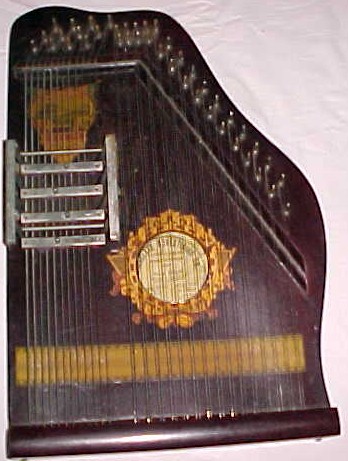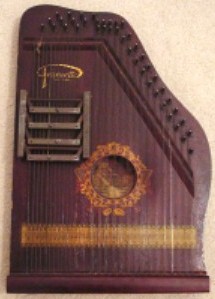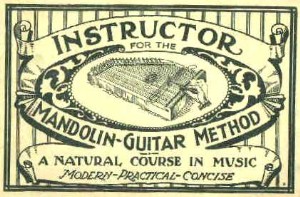
Form 1a

Form 1b
Pianoette - Samuel C. Osborn
The instrument began with a patent applied for by Charles Habermann in 1916, which was assigned to Oscar Schmidt, Inc. The patent, which shows a drawing identical to manufactured form, covers the chord-playing attachment. Habermann had the idea as early as 1913, when he applied for a patent on a simliar but more complicated mechanism. That patent was granted as well, but his second is the one which describes the mechanism which was actually sold.
Form 1 of the Pianoette is different from most of the instruments in the family of chord zithers, in that it does not have its accompaniment strings grouped in chords. Habermann's design instead has a single group of 12 accompaniment strings, which are sounded in different combinations to produce the chords. Each bar has segments of hard felt glued underneath, whose positions correspond to the notes of the desired chord. The bar is mounted on thin springy strips, which hold it normally in a position slightly above the chord strings. Each bar has a small knob, and the player lifts the bar with the knob and releases it. The spring action of the mounting drives the bar downward to strike the strings. The bar then bounces off the strings and returns to its neutral position.
The design allows the formation of 4 chords from 12 strings instead of the usual 16, but it does create a more expensive instrument by requiring the mechanism. It also doesn't permit a playing style which separates the bass note from the rest of the chord - the bar bangs on the entire chord at once.
All of the instruments of Form 1 contain a label for Samuel Osborn, and though it seems likely that OS was supplying him with these instruments (note that the soundhole label says "Manufacturer's Agent"), there's no other instrument known with this outline that contains any label other than Osborn's. The advertising sheet which comes with these instruments is delightful - "Grips the Mind, Binds the Heart - The Pianoette", it says. A rather phrenological-looking head is connnected by lots of rays to a picture of the instrument - and it finishes by trumpeting "Psychologically Correct."
|
Form 1a |
Form 1b |
Note that all examples of Form 1 use soundhole decal SH116, and either soundboard decal SB116 or the Pianoette decal.
|
|
|
The standard Osborn label appears inside the soundhole, with varying prices. (The Masonic Temple is gone, but the Phelan Building still stands today.)
|
Form 2 |
Form 3 |
In these forms, the outline of the body has changed (and now looks suspiciously like that of the Marxophone), and the accompaniment has been converted to the more customary chord groups. But there are still chord playing attachments; the one on Form 2 is similar in concept to that of the Chartola. The compound hammer mechanism on Form 3 is shown in exact detail in a patent, also applied for in 1916, granted to none other than Frederick Menzenhauer! The patent record indicates no assignment to any company, and as far as is known, there was no firm connection at that time between Menzenhauer and Oscar Schmidt, Inc. It may be that Menzenhauer simply sold the patent to OS. The final oddity is that Osborn himself applied for a patent on a compound hammer, just 3 months after Menzenhauer's application. The lower part of the hammer actually resembles the one that appears on Form 3 (and in Menzenhauer's patent) but the other part is quite different.
And these forms contain some of those tantalizing and puzzling links between multiple major manufacturers. The Form 1 instrument was almost certainly an Oscar Schmidt production, and the Form 3 mechanism has at least a circumstantial connection with OS. But the "Pianoette" decal on the mechanism appears on other instruments completely unlike this one, which are identical to the Marx Pianolin. (Many of those instruments even include a soundhole label which shows "Pianoette Advertising Co.") And note the small moveable panel on Form 3. It's been flipped upside down in this photo - the rectangle of gray felt normally rests against the hammers. The side that you can't see contains the "Conservatory Quality" decal which decorated several varieties of Marx instruments. And that soundhole decal - it also appears on a one-stringed Marx "violin", and on the Marx Liberty Harp, and on the second form of Marx's Pianophone.
Note finally the spring hammer shown with the Form 2 instrument. These were supplied with many of the chord zithers, well into the second half of the century.

The often-seen "Mandolin-Guitar Method" describes how to use it: strike strings to get a single note, or bring the "handle" down sharply so the felt protector contacts the end cover, and the springy shaft will allow the head to bounce against the string multiple times, producing a mandolin effect.
Here are soundhole labels from Form 2 instruments.
|
|
|
Drop me a line.
Go back to the Guitar-Zither Clearinghouse, or home.
This page was banged out with Word 97, 6 Jan 02.